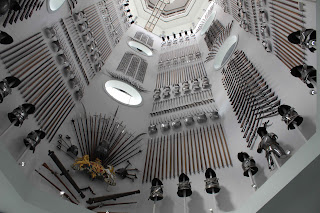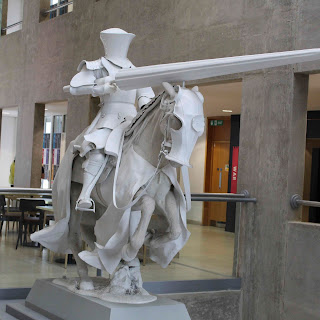As I have discussed previously, knights in the twelfth century normally wore chain mail, made of iron rings riveted or welded together to provide protection against swords and other weapons. Although we have plenty of illustrations from the period of chain mail, actual chain mail from the twelfth century is now essentially non-existent. It would be used until it disintegrated, and it was especially subject to rust.
When we think of armor we usually think instead of plate armor. Here we have lots of surviving examples, the earliest from the thirteenth century but continuing up through the seventeenth century. England's Tower of London long collected helmets and swords from the late medieval and early modern periods. Recently these have been moved to their own museum in Leeds (Yorkshire), called (appropriately enough) the Armouries. The entryway is seen below.
The person responsible for making all the pre-modern armor was known (again appropriately) as an armourer. It was a highly skilled occupation, and armourers had their own late medieval guilds. A royal court would have several armourers on staff, and they were kept busy.
Plate armor was made from steel, not iron, produced by working the charcoal from the great furnaces (used to melt iron) into the metal. Because most medieval iron came out of mines in Germany, that region also became the center of steel making. Armor made by German armourers might be sold all over Europe. Plates of steel, ready to be made into armor, would also be sold, or a powerful lord might buy raw iron to be worked up locally.
The armourer was in many ways like a blacksmith, using metal, a furnace, and hammer and anvil to shape metal into protective gear. The advantage of plate armor over chain mail was that it was designed to deflect the blow of a sword or lance, even to turn aside a bullet unless it came in on a perfectly direct course. Late medieval helmets often took on fanciful shapes, which while certainly embracing fashion, were ultimately based on theories of the best shapes to send an incoming shot or blow skittering away.
Realistically plate armor will not do a lot against musket fire, and it's useless against cannon fire, but it was highly effective against the footsoldiers increasingly pressed into service in late medieval warfare. A heavily armored knight on a heavily armored horse could ride down footsoldiers with impunity.
But plate armor achieved its great flourishing in post-medieval tournaments. When the cavalry charges, for which tournaments had originally been designed to train knights, no longer served in wars fought with cannons and pikemen on foot, tournaments became very popular games for the powerful. The above mounted knight is clearly a tournament fighter.
The heavy plate armor used for tournaments of the early modern period would have been awkward and confining in a regular battle. But it didn't matter. Knights would be hoisted into the saddle with cranes and aimed at each other. Armourers really came into their own, shaping the armor to fit each individual, decorating it with scenes from epics or tales of antiuity, inventing new styles. King Henry VIII of England loved such tournaments. Several of his suits of armor survive, getting larger and larger around over the years as he did.
© C. Dale Brittain 2024
For more on medieval knights, see my new ebook, Positively Medieval: Life and Society in the Middle Ages. Also available in paperback.







